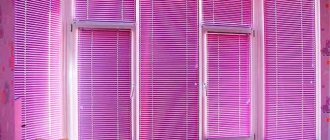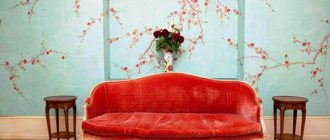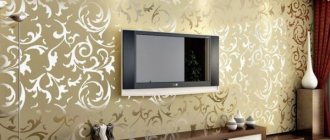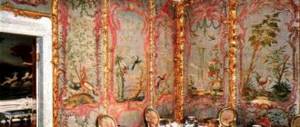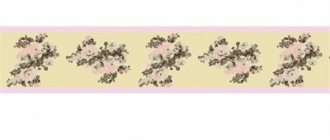Repair and decoration
04/22/2018 Anastasia Prozheva
Blinds are that item in the house with which you can beautifully decorate any room. Blinds are a charming type of decor. They can turn an ordinary room into an original and beautiful room. They are also able to protect the room from scorching sun rays. They can be used not only in rooms, but also in the kitchen, hallway, balcony, loggia, and country house. You can buy blinds in a store or make your own.
History of occurrence and types of blinds
Blinds owe their appearance to the Indians of the West Indies. The first type of blinds is colonial. It is characterized by the presence of shutters with sloping wooden slats. They reliably protect from the sun and have the special advantage of being low cost. In temperate climates, Venetian blinds began to be made in the 18th century. Their design is characterized by the fact that the inner long sides are fixed in the frame with hinges, and the outer ones with a cord, thus making it possible to adjust the tilt of the lamps depending on the weather and time of year.
For the Russian climate, blinds that are capable of transmitting light are recommended
Types of blinds differ in design depending on the climate zone and the material from which they are made.
Types of blinds as they appear:
- Horizontal;
- Vertical.
The complex mechanism of blinds with separate lamps often breaks down. Even the most expensive curtains are not immune from them. Therefore, the advantage of homemade blinds is the simplicity and reliability of the mechanism.
The most popular types of blinds
Each type of blinds has a different design, materials and different adjustment methods. Knowing the advantages and disadvantages of each, you can choose the most convenient and suitable type.
Horizontal blinds and pleated blinds are the most preferred option for people who want to regulate the level of light in their home
The most popular types:
- Vertical blinds are curtains in which strips of material called slats are arranged vertically and can be rotated at the desired angle. These blinds are adjustable using a cord.
- Horizontal blinds – characterized by a system called “ladder”. The slats are arranged horizontally. The slats are adjusted using a special drum.
- Roller blinds are a fabric sheet that is rolled into a roll using a special mechanism.
- Pleated blinds are a canvas made of fabric folded in the shape of an accordion. They are adjusted using special cords and threads, at the ends of which clamps are attached.
Roller blinds are best suited for the living room
When choosing a certain type of blinds, you should pay attention to the shape of the windows, the material from which the curtains are made, and ease of adjustment.
Scope of application of the finished accessory in everyday life
DIY wallpaper blinds are an economical solution to the problem of heat and stuffiness in rooms located on the sunny side of the house. They can also be used as decorative decorations. Resourceful people also use this invention during repairs.
They quickly make protective blinds and hang them on the windows while whitewashing and wallpapering, thereby preventing contamination of the glass with glue, paint, enamel, plaster composition for wall decoration, etc. Upon completion of the repair, the accessory is dismantled in a few minutes, enjoying clean and shining windows frames.
The accessory can also be used in commercial buildings. With their help, you can revive the boring office decoration of a business space, store or warehouse. Any business owner can afford such decor, because to purchase it you will not have to redraw the company’s budget and look for ways to save money.
How to make blinds from wallpaper with your own hands
Making your own blinds from wallpaper will be easy and interesting even for people far from needlework. The work will not take much time, and the costs of such curtains will be minimal.
To create blinds from wallpaper, use double-sided tape
Required materials and tools:
- Wallpaper (you can use leftovers);
- Scissors;
- Awl or hole punch;
- Ruler;
- Meter;
- Pencil;
- Satin ribbon or cord (it is important to match them to the wallpaper);
- Scotch tape (regular and double-sided);
- Retainer;
- Glue.
Materials for blinds can be found in every home, so there will be no difficulties in preparing them.
It is best to make white blinds: they can make the room visually wider
When choosing wallpaper, it is important to pay attention to the following criteria: the material should be dense, transmit light, not too dark and not too colorful.
When the material and tools are available, you can begin making blinds.
Unusual DIY blinds made from wallpaper: their main advantages
Blinds appeared a long time ago; they began to be used back in the 14th century in countries with hot climates. This is the most effective method to protect the room from heat. Blinds are more practical than curtains; they can be washed and cleaned without removing them from the window. If you cannot purchase ready-made blinds, then make them yourself.
These wallpaper blinds will last a very long time, and if you get tired of the color, you can easily make new ones
DIY wallpaper blinds will look very original in any room. With them, the room will look bright and chic, to the envy of the neighbors
Homemade blinds will make your room unique, and you won’t have to throw away the beautiful pieces of wallpaper that you have left over after renovation.
Advantages of blinds made from wallpaper:
- Multifunctionality;
- Suitable for any window;
- Economical;
- Very easy to make.
Paper blinds can replace regular curtains in your home and at the same time you will save your money. They will also help refresh your interior by adding bright colors. In this case, you can get blinds in exactly the color you want.
Related article: Cascade waterfall mixer: beauty and comfort
Master class on making blinds from wallpaper
There are many master classes on this topic. They all contain almost the same step-by-step instructions with variations depending on the type of blinds being made.
When calculating the width of the curtains, add a few centimeters to the width of the window
Step-by-step actions:
- Measure the width and length of the glass.
- 25 percent should be added to the length value, while the width should remain unchanged. The length of the ribbon or cord must be taken with an allowance, taking into account tying bows and knots.
- Cut a rectangle of the desired size from a piece of wallpaper. If the wallpaper has a pattern, it is important not to disturb it.
- Fold a rectangle of wallpaper like an accordion. The folds should be approximately 3 to 5 cm. When changing the length, the appearance of the curtains may deteriorate. The correct execution can be checked at the end of the work - the end of one side of the canvas should look like the letter “L”. This end will become the bottom of the blind.
- Measure the middle of the canvas, make holes using an awl or hole punch. The back of the hole should be secured with tape. Repeat the action.
- You need to thread a ribbon or cord into the resulting gap. Straighten the blinds to determine the length of the tape. The upper end of the tape should be secured with a knot.
- Make a mount to the window. Attach double-sided tape to the entire side of the upper end of the canvas. This way you can also secure the cord additionally.
- On the bottom strip at the bottom left, glue less than half a piece of double-sided tape. It will help in decorating curtains.
- Decorate the bottom with a “peacock tail”. Glue together the five lower folds of the fabric. Secure with double-sided tape. Bring the cord to the back side, trim off the excess.
- Place a lock on the cord. The retainer must consist of one opening. The fastener should be pulled up; if you need to raise the curtains, close the window, lower the fastener down along the cord. The bottom of the cord can be decorated with a large bead or other decorative element.
This is one option for wallpaper blinds. There are many options. For example, you can make curtains on two cords parallel to each other. The order of work will be similar, with the difference that a double lock will be needed.
DIY wallpaper blinds: step-by-step instructions and master class (photo, video)
The first stage is preparatory. The necessary measurements should be taken, namely measuring the window parameters. So, the width of the product is the size of the glass part, the length is the height + 10-20 cm.
Important! The reserve is needed to compensate for what the accordion steals.
Measuring window parameters
Advice! In order not to make a mistake with the dimensions, especially the length, it is better to first make an accordion and then cut it.
It is convenient to mark the width of the planks on the reverse side with a pencil and fold according to this marking. The following is the order:
1. Fold the entire fabric into an accordion so that you get one dense strip.
2. Mark the place for the puncture - the cord will be passed here to adjust the opening/closing. You can only pierce such thickness with a sharp awl.
3. Slightly straighten the accordion so that the cord can fit through the hole. This is also convenient to do with a “gypsy” needle.
4. After this, straighten the accordion, fasten the cord at the top and tie it with a knot. To prevent it from coming undone, we recommend sealing the edges with transparent tape. At the bottom you should leave a reserve of cord - 20-30 cm.
5. The options for continuing the work are as follows: glue the cardboard along the bottom or lift it exactly in the middle, which will form a beautiful rounded “tail”. The first option is convenient in that you can raise them and lower them to the required illumination of the room, but due to the fact that the cardboard is much denser, it will sag in the center. This can be eliminated by adding another cord and a lock in the center of the canvas.
6. The final stage is the installation of the clamp, with its help it is easy to control the height of the canvas. A decorative tip can be attached to the bottom of the cord.
7. The canvas is attached to the window using double-sided tape.
Advice! If you wish, you can add decorative elements - bead threads, appliqués. Multi-colored, bright pleated blinds made from wallpaper add a special charm to panoramic windows.
How to make blinds from wallpaper with your own hands (video)
Making blinds from wallpaper yourself is an excellent option if you need to quickly curtain the windows to protect the room from sunlight. In every home there is always a leftover piece of wallpaper that will be an excellent source material for future blinds. To make curtains you will need about two hours of time and a basic set of standard tools. Blinds made by yourself will look beautiful on the windows, protect from light and delight the eye with handmade work.
DIY wallpaper curtains: review of non-standard options
In addition to classic blinds with a solid canvas, craftsmen can create many other configurations. Pleated wallpaper, canvases with parallel cords threaded through a latch and other stylish and unusual wallpaper crafts look interesting. They can be additionally decorated with appliqués, small decorations, and bright laces.
Looking through the photos that show stylish ideas for the home and soul, the craftsmen will note that blinds can be transformed in other ways. Their choice is limitless, so all that remains is to find a non-trivial and original idea to your liking and implement it in practice.

